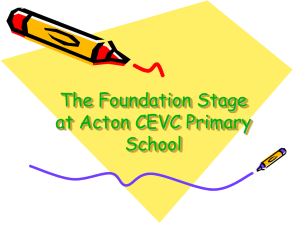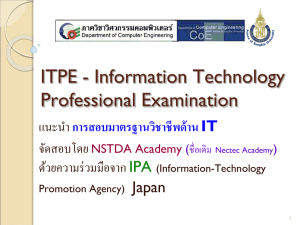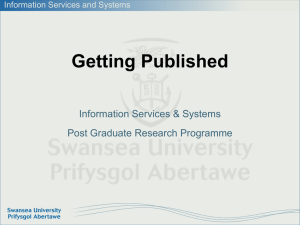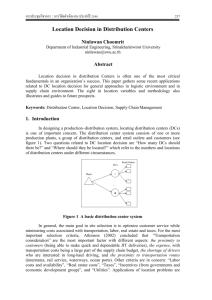By Narongrit Sombatsompop
advertisement
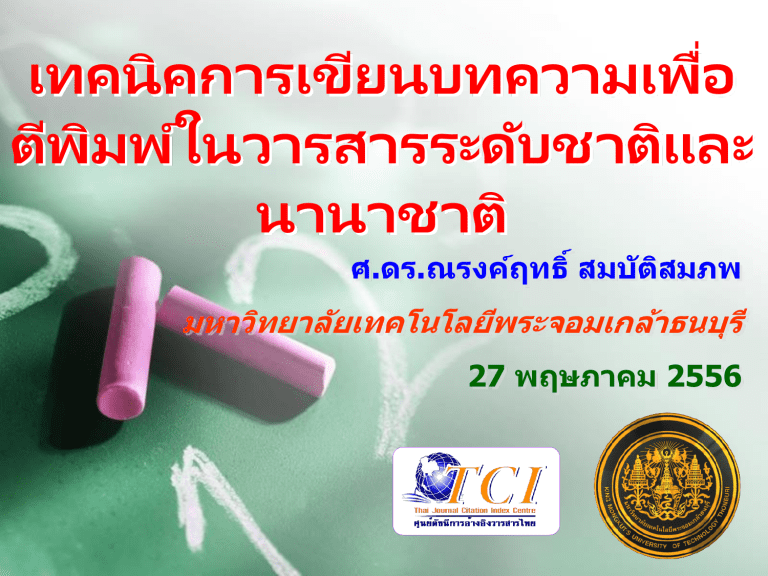
่ เทคนิ คการเขียนบทความเพือ ตีพม ิ พ ์ในวารสารระดับชาติและ นานาชาติ ศ.ดร.ณรงค์ฤทธิ์ สมบ ัติสมภพ มหาวิทยาล ัยเทคโนโลยีพระจอมเกล้าธนบุร ี 27 พฤษภาคม 2556 Writing a paper, and getting it accepted are skill, not knowledge to learn from anyone! ผลงานวิจย ั ทางวิชาการ กับ ข้อ วิพากษ ์จากสังคม ้ ง้ ใช้ 1. ผลงานวิจ ัยตีพม ิ พ ์ = ผลงานขึนหิ ประโยชน์อะไรไม่ได้ paper กินไม่ได้ ่ นการตีพม 2. นักวิจ ัยทีเน้ ิ พ ์ ถูกเรียกว่า เสือ กระดาษ / ปลวก เห็นแก่ต ัว เห็นแก่ ความก้าวหน้าของตนเอง 3. ผลงานวิจ ัยตีพม ิ พ ์ ใช้เงินภาษี แต่ไม่ให้ อะไรก ับสังคม 4. ผลงานตีพม ิ พ ์ในวารสารนานาชาติ ใช้เงิน สมอง และแรงงานไทย แต่ให้ชาวต่างชาติ อ่าน By Narongrit Sombatsompop 5. ผู บ ้ ริหารหน่ วยงาน อยากให้ท างานวิจ ัย 3 ปั จจุบน ั ...อะไร? กาหนดทิศทาง งานวิจย ั เชิงวิชาการ (ตีพม ิ พ ์) 1. เกณฑ ์การจบการศึกษาของนักศึกษา ป.โท และ ป. ่ เอก กาหนดโดย สกอ. และทุกคนก็ตอ ้ งเชือและปฏิ บต ั ิ (อย่างเคร่งคร ัด) 2. เกณฑ ์การศึกษาต่อ (หากหัวไม่ด ี ไป (เอา) หา paper มา) ในระดับ ป.เอก 3. เกณฑ ์การร ับอาจารย ์ของมหาวิทยาลัยบางแห่ง (ที่ ่ ่ 0) ไม่ตอ ้ งการเริมที 4. การขอสนับสนุ นทุนวิจย ั และการได้ร ับรางวัล ต้องการ track record ด้าน publications (เช่น สกว. ฝ่ายวิชาการ) 5. เกณฑ ์การประเมินตาแหน่ งวิชาการของอาจารย ์ที่ ้ ยังอิงผลงานวิจย ั ตีพม ิ พ ์ (กติการ สกอ. อีกนันแหละ) 4 6. การจัดอ ันดบ ั ความเข้มแข็งทางวิByชNarongrit าการ Sombatsompop (เกือบ ้ าไม่การ เกิดอะไรขึนถ้ ตีพม ิ พ ์เผยแพร่? 1. ความรู ้มีอายุขย ั (คนตาย ความรู ้ตาย) ้ ่ ไปถึ งไหนแล้ว? รู ้ 2. ไม่รู ้ว่างานวิจ ัยเรืองนี อะไรบ้างแล้ว? และต้องรู ้อะไรอีก? 3. ไม่มผ ี ลสรุปข้อเท็จจริง (ขาดเวทีการโต้ตอบ ทางวิชาการ โดยเฉพาะในระด ับสากล) 4. ก็ไม่ตอ ้ งวิจ ัยอะไรให้ลก ึ ไม่ตอ ้ งรู ้ทฤษฎีมาก นัก 5. ทางานวิจ ัยแบบแก้ปัญหา เป็ นหลัก อายุมาก ้ เก่งเอง ขึนก็ 6. ไม่ม ี ศ. ในมหาวิทยาลัย By Narongrit Sombatsompop 5 ่ 7. ไม่มใี ครรู ้จักนักวิจ ัยไทย เราชื นชมกั นเองก็ ความสาค ัญของการตีพม ิ พ์ผลงานวิจ ัย ึ ษาควรได ้รั บ การฝึ กให ้เผยแพร่ผ ลงานวิจั ย ในทุก ประเภท 1. บัณ ฑิต ศ ก ิ ธิบต (วารสาร ทีป ่ ระชุมวิชาการ และสท ั ร) 2. ถือ เป็ น contributions ที่เ ป็ นการเผยแพร่อ งค์ค วามรู ้ อัน จะเป็ น ประโยชน์ตอ ่ วงการวิชาการ และสงั คม 3. ฝึ กนิ สั ย การเขีย นและสรุ ป ใจความส าคั ญ ของงานทั ้ง หมดก่ อ นจบ ึ ษา (อาจรวมถึงการฝึ กภาษาด ้วย) การศก ั้ 4. เป็ นฉบับย่อของสาระและบทสรุปทีส ่ าคัญ สามารถเข ้าใจได ้ในเวลาสน 5. ถือเป็ นกลไกการกลั่นกรองคุณภาพผลงานอีกครัง้ หนึง่ (นอกเหนือจาก กรรมการวิทยานิพนธ์) โดยกระบวนการ peer review (blinded or double blinded) 6. เป็ นการผลิต ป.เอก ในประเทศ มาตรฐานสากล (ป.เอก ทีต ่ ้องตีพม ิ พ์ ในวารสารนานาชาติ) ยกระดับคุณภาพวิชาการ 7. แสดงให ้เห็นถึงความสามารถทางการวิจัย ของบุคคล หน่วยงาน และ ประเทศ (รวมถึง track record และ promotion ต่างๆ เป็ นต ้น) By Narongrit Sombatsompop 6 What are basic requirements for scientific publications? • Suitability to the journal • Novelty or Originality • Related references and its competitions • Good manuscript’s organization, including scientific writing style. • Length (wordy/repetitive>> concise/clear) • Good command of English usage By Narongrit Sombatsompop 7 Manuscript composition s • Front page: title, author (s) & addresses • Abstract and keywords • Introduction • Experimental • Results & Discussion • Conclusions • Acknowledgments • References • Tables • Figures or Illustrations or line drawing By Narongrit Sombatsompop 8 How to select an appropriate journal ? • Journals with relevant contents (aims and scope) • Journals with high total citations • Highly recommended well-known by researchers in the field. • Indexed in international databases • Journals with high journal impact factors, h-index, SJR (Q1-Q4) or SNIP By Narongrit Sombatsompop 9 Tips in publication Make the most suitable journal with high visibilities. • Select the right referees (preferred and biased). • Using your own references (published in good journals), but must be related. • Some words may be used in the abstract such as unique, first time, plausible, never been reported or published etc. • Submitting related papers in series (or in parts) in the same journal. • Do not submit a paper to more than one journals at the same time. • Self-plagiarism is also prohibited by copyrighting. By Narongrit Sombatsompop 10 Tips in publication (continued) • If asked to revise, do it as quickly as you can. • Multiple revisions may turn into more citations in the future. • If rejected, there are many things to do as follows: • Read-read and read the comments, but editor’s decision is more important. • Modify the manuscript of the agreed points and resubmit (to another journal). Wait and see the comments. • Re-working to disprove the referee’s reservations. • Rejected paper makes a new accepted publication. By Narongrit Sombatsompop 11 Tips in publication (continued) • Papers from multi-, inter- or trans-disciplinary researches are more likely to be accepted. • Papers from good conferences tend to be more successful in journal publication. • Avoid to name the main findings (equation, mechanism etc) after your own names unless you have sufficient citations to the work. • Good or understandable English is required. • Knowing the editors in the conferences is beneficial. • Knowing the referee’s form is also useful (for self evaluations) • Referee’s numbers of journals (seeking from your friends). The more the better. By Narongrit Sombatsompop 12 Thank You




